Guidance on Claiming Damages for Non-Pecuniary Losses in Contract Law
VerifiedAdded on 2023/01/11
|8
|2966
|50
Essay
AI Summary
This essay provides an overview of the English court's guidance on claiming non-pecuniary damages in contract law. It explores the legal framework, types of damages (including pain, suffering, mental illness, and emotional distress), and the process of claiming compensation. The essay emphasizes the importance of distinguishing between tort and contract law, as well as the different approaches to valuation. It also highlights the significance of the court's guidance in determining the validity of claims, establishing limits, and addressing issues related to breach of contract. Furthermore, the essay examines the concepts of functional, personal, and conceptual approaches to compensation, and discusses how these concepts are applied in the assessment of non-pecuniary damages. The essay concludes by emphasizing the benefits of the English court's guidance in clarifying the process of claiming non-pecuniary damages in contract law and providing a framework for valid claims.

World
1
1
Secure Best Marks with AI Grader
Need help grading? Try our AI Grader for instant feedback on your assignments.
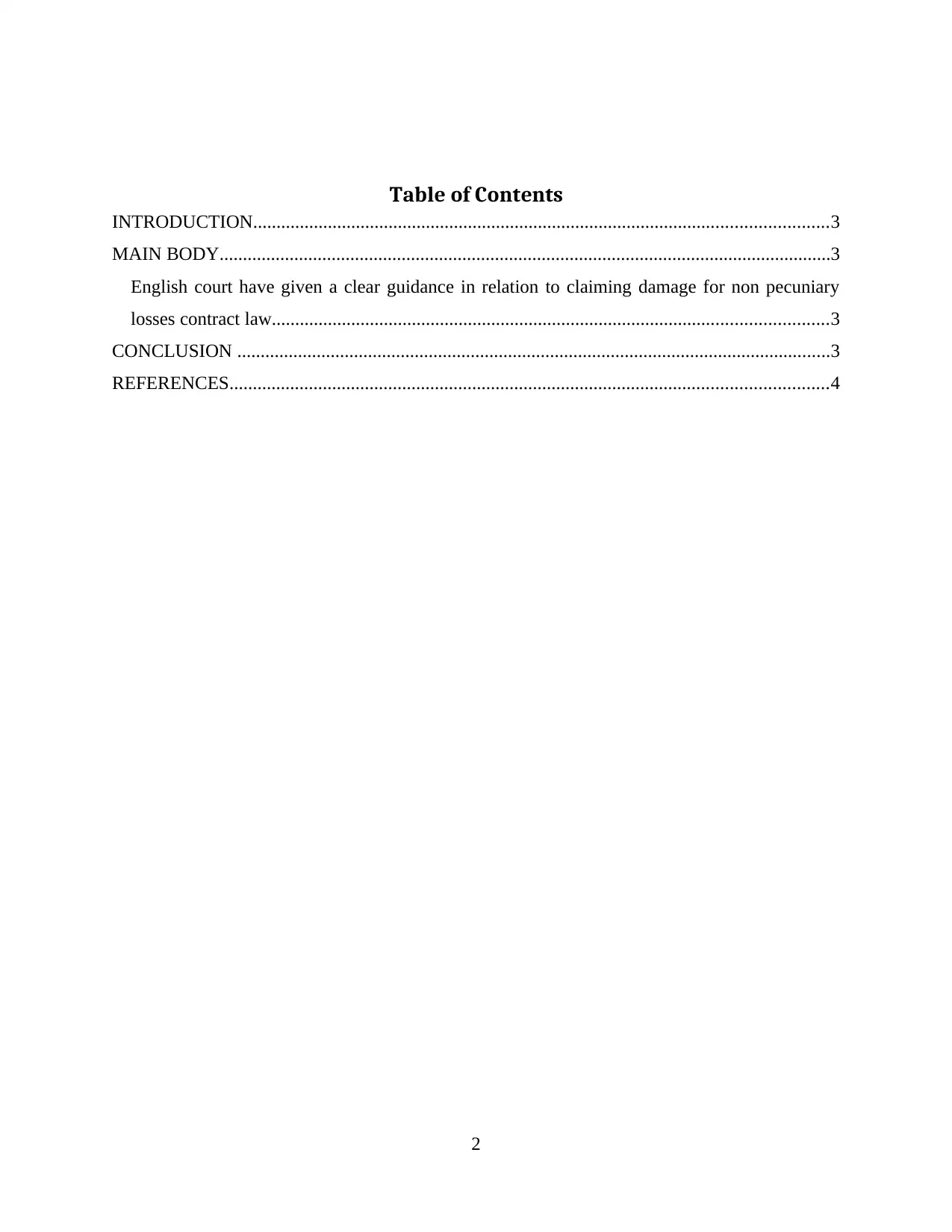
Table of Contents
INTRODUCTION...........................................................................................................................3
MAIN BODY...................................................................................................................................3
English court have given a clear guidance in relation to claiming damage for non pecuniary
losses contract law.......................................................................................................................3
CONCLUSION ...............................................................................................................................3
REFERENCES................................................................................................................................4
2
INTRODUCTION...........................................................................................................................3
MAIN BODY...................................................................................................................................3
English court have given a clear guidance in relation to claiming damage for non pecuniary
losses contract law.......................................................................................................................3
CONCLUSION ...............................................................................................................................3
REFERENCES................................................................................................................................4
2
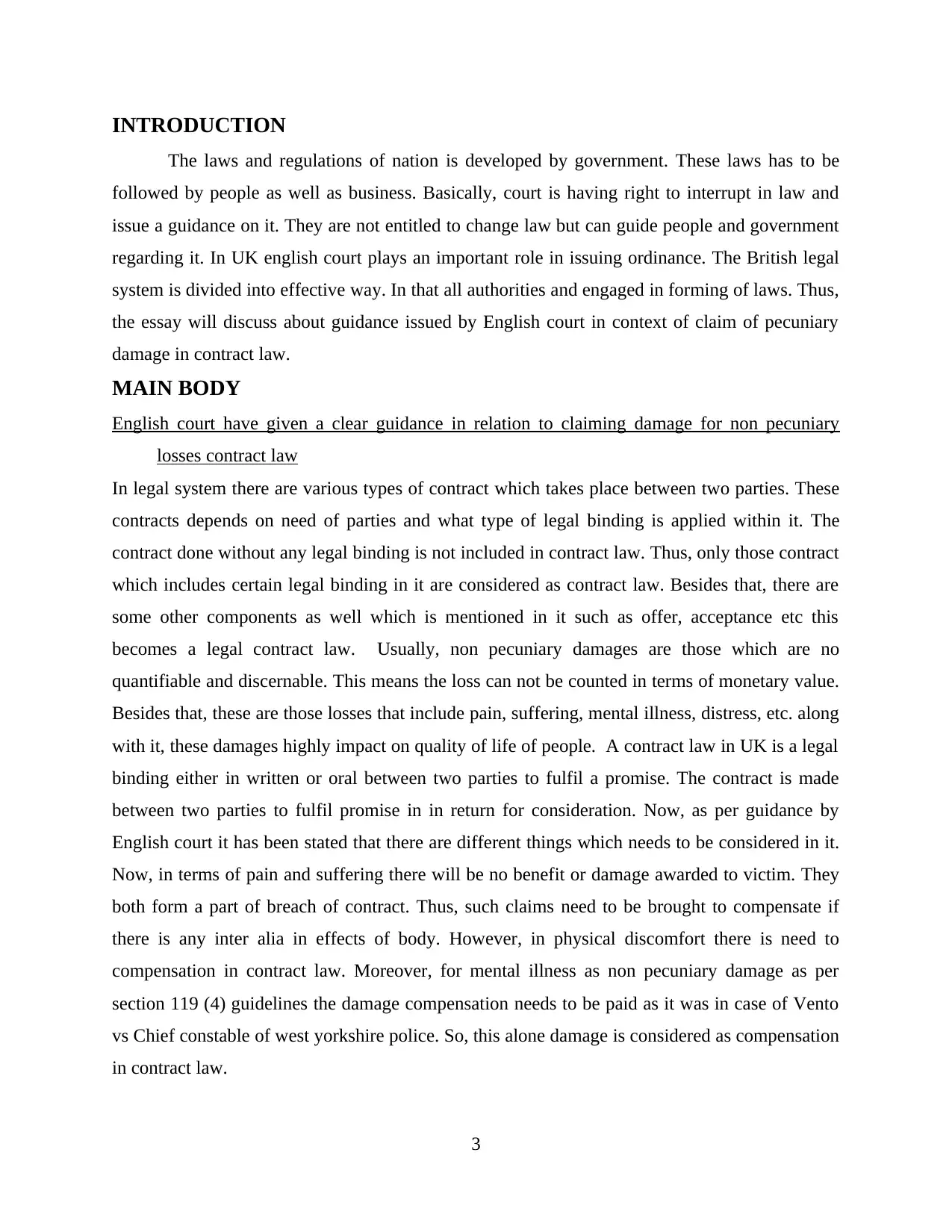
INTRODUCTION
The laws and regulations of nation is developed by government. These laws has to be
followed by people as well as business. Basically, court is having right to interrupt in law and
issue a guidance on it. They are not entitled to change law but can guide people and government
regarding it. In UK english court plays an important role in issuing ordinance. The British legal
system is divided into effective way. In that all authorities and engaged in forming of laws. Thus,
the essay will discuss about guidance issued by English court in context of claim of pecuniary
damage in contract law.
MAIN BODY
English court have given a clear guidance in relation to claiming damage for non pecuniary
losses contract law
In legal system there are various types of contract which takes place between two parties. These
contracts depends on need of parties and what type of legal binding is applied within it. The
contract done without any legal binding is not included in contract law. Thus, only those contract
which includes certain legal binding in it are considered as contract law. Besides that, there are
some other components as well which is mentioned in it such as offer, acceptance etc this
becomes a legal contract law. Usually, non pecuniary damages are those which are no
quantifiable and discernable. This means the loss can not be counted in terms of monetary value.
Besides that, these are those losses that include pain, suffering, mental illness, distress, etc. along
with it, these damages highly impact on quality of life of people. A contract law in UK is a legal
binding either in written or oral between two parties to fulfil a promise. The contract is made
between two parties to fulfil promise in in return for consideration. Now, as per guidance by
English court it has been stated that there are different things which needs to be considered in it.
Now, in terms of pain and suffering there will be no benefit or damage awarded to victim. They
both form a part of breach of contract. Thus, such claims need to be brought to compensate if
there is any inter alia in effects of body. However, in physical discomfort there is need to
compensation in contract law. Moreover, for mental illness as non pecuniary damage as per
section 119 (4) guidelines the damage compensation needs to be paid as it was in case of Vento
vs Chief constable of west yorkshire police. So, this alone damage is considered as compensation
in contract law.
3
The laws and regulations of nation is developed by government. These laws has to be
followed by people as well as business. Basically, court is having right to interrupt in law and
issue a guidance on it. They are not entitled to change law but can guide people and government
regarding it. In UK english court plays an important role in issuing ordinance. The British legal
system is divided into effective way. In that all authorities and engaged in forming of laws. Thus,
the essay will discuss about guidance issued by English court in context of claim of pecuniary
damage in contract law.
MAIN BODY
English court have given a clear guidance in relation to claiming damage for non pecuniary
losses contract law
In legal system there are various types of contract which takes place between two parties. These
contracts depends on need of parties and what type of legal binding is applied within it. The
contract done without any legal binding is not included in contract law. Thus, only those contract
which includes certain legal binding in it are considered as contract law. Besides that, there are
some other components as well which is mentioned in it such as offer, acceptance etc this
becomes a legal contract law. Usually, non pecuniary damages are those which are no
quantifiable and discernable. This means the loss can not be counted in terms of monetary value.
Besides that, these are those losses that include pain, suffering, mental illness, distress, etc. along
with it, these damages highly impact on quality of life of people. A contract law in UK is a legal
binding either in written or oral between two parties to fulfil a promise. The contract is made
between two parties to fulfil promise in in return for consideration. Now, as per guidance by
English court it has been stated that there are different things which needs to be considered in it.
Now, in terms of pain and suffering there will be no benefit or damage awarded to victim. They
both form a part of breach of contract. Thus, such claims need to be brought to compensate if
there is any inter alia in effects of body. However, in physical discomfort there is need to
compensation in contract law. Moreover, for mental illness as non pecuniary damage as per
section 119 (4) guidelines the damage compensation needs to be paid as it was in case of Vento
vs Chief constable of west yorkshire police. So, this alone damage is considered as compensation
in contract law.
3
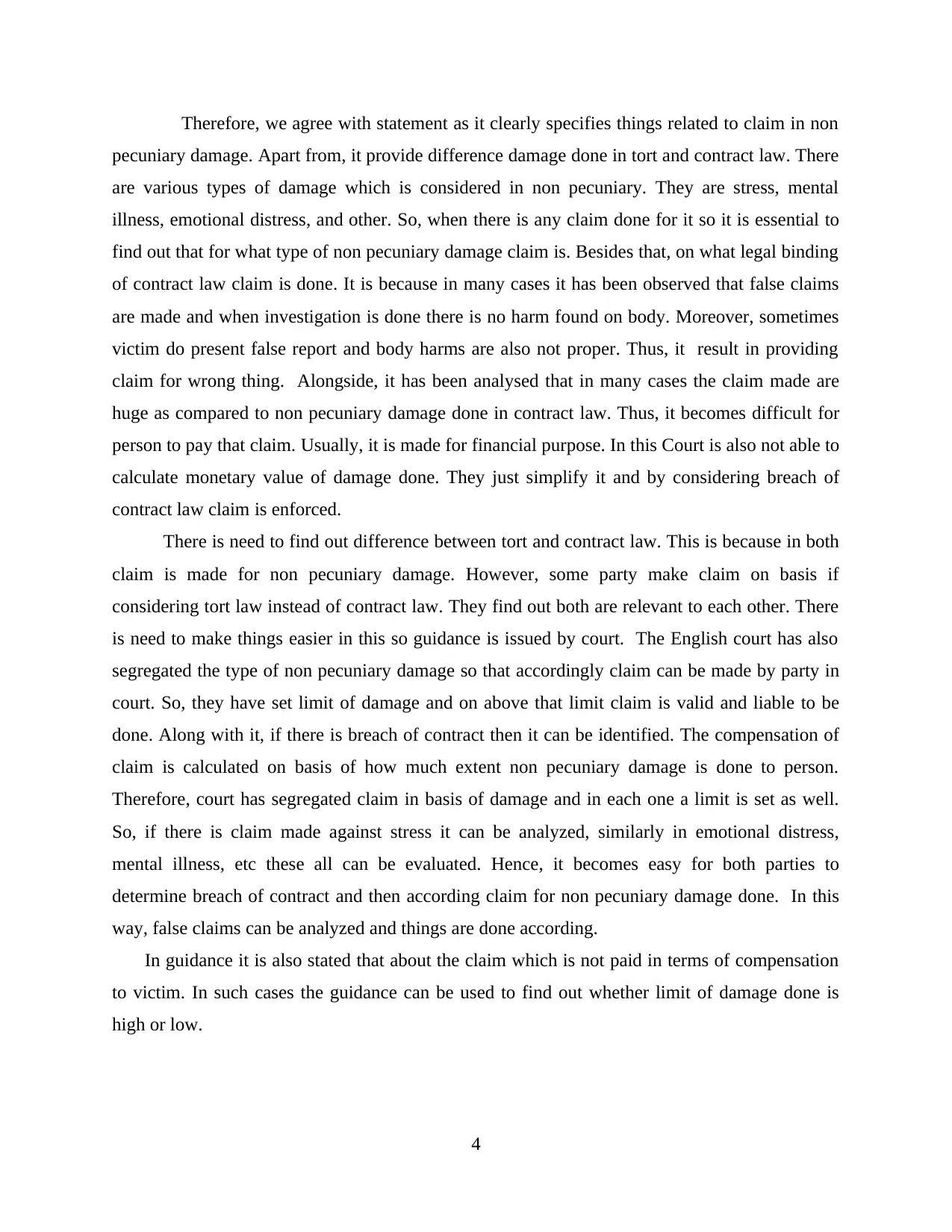
Therefore, we agree with statement as it clearly specifies things related to claim in non
pecuniary damage. Apart from, it provide difference damage done in tort and contract law. There
are various types of damage which is considered in non pecuniary. They are stress, mental
illness, emotional distress, and other. So, when there is any claim done for it so it is essential to
find out that for what type of non pecuniary damage claim is. Besides that, on what legal binding
of contract law claim is done. It is because in many cases it has been observed that false claims
are made and when investigation is done there is no harm found on body. Moreover, sometimes
victim do present false report and body harms are also not proper. Thus, it result in providing
claim for wrong thing. Alongside, it has been analysed that in many cases the claim made are
huge as compared to non pecuniary damage done in contract law. Thus, it becomes difficult for
person to pay that claim. Usually, it is made for financial purpose. In this Court is also not able to
calculate monetary value of damage done. They just simplify it and by considering breach of
contract law claim is enforced.
There is need to find out difference between tort and contract law. This is because in both
claim is made for non pecuniary damage. However, some party make claim on basis if
considering tort law instead of contract law. They find out both are relevant to each other. There
is need to make things easier in this so guidance is issued by court. The English court has also
segregated the type of non pecuniary damage so that accordingly claim can be made by party in
court. So, they have set limit of damage and on above that limit claim is valid and liable to be
done. Along with it, if there is breach of contract then it can be identified. The compensation of
claim is calculated on basis of how much extent non pecuniary damage is done to person.
Therefore, court has segregated claim in basis of damage and in each one a limit is set as well.
So, if there is claim made against stress it can be analyzed, similarly in emotional distress,
mental illness, etc these all can be evaluated. Hence, it becomes easy for both parties to
determine breach of contract and then according claim for non pecuniary damage done. In this
way, false claims can be analyzed and things are done according.
In guidance it is also stated that about the claim which is not paid in terms of compensation
to victim. In such cases the guidance can be used to find out whether limit of damage done is
high or low.
4
pecuniary damage. Apart from, it provide difference damage done in tort and contract law. There
are various types of damage which is considered in non pecuniary. They are stress, mental
illness, emotional distress, and other. So, when there is any claim done for it so it is essential to
find out that for what type of non pecuniary damage claim is. Besides that, on what legal binding
of contract law claim is done. It is because in many cases it has been observed that false claims
are made and when investigation is done there is no harm found on body. Moreover, sometimes
victim do present false report and body harms are also not proper. Thus, it result in providing
claim for wrong thing. Alongside, it has been analysed that in many cases the claim made are
huge as compared to non pecuniary damage done in contract law. Thus, it becomes difficult for
person to pay that claim. Usually, it is made for financial purpose. In this Court is also not able to
calculate monetary value of damage done. They just simplify it and by considering breach of
contract law claim is enforced.
There is need to find out difference between tort and contract law. This is because in both
claim is made for non pecuniary damage. However, some party make claim on basis if
considering tort law instead of contract law. They find out both are relevant to each other. There
is need to make things easier in this so guidance is issued by court. The English court has also
segregated the type of non pecuniary damage so that accordingly claim can be made by party in
court. So, they have set limit of damage and on above that limit claim is valid and liable to be
done. Along with it, if there is breach of contract then it can be identified. The compensation of
claim is calculated on basis of how much extent non pecuniary damage is done to person.
Therefore, court has segregated claim in basis of damage and in each one a limit is set as well.
So, if there is claim made against stress it can be analyzed, similarly in emotional distress,
mental illness, etc these all can be evaluated. Hence, it becomes easy for both parties to
determine breach of contract and then according claim for non pecuniary damage done. In this
way, false claims can be analyzed and things are done according.
In guidance it is also stated that about the claim which is not paid in terms of compensation
to victim. In such cases the guidance can be used to find out whether limit of damage done is
high or low.
4
Secure Best Marks with AI Grader
Need help grading? Try our AI Grader for instant feedback on your assignments.
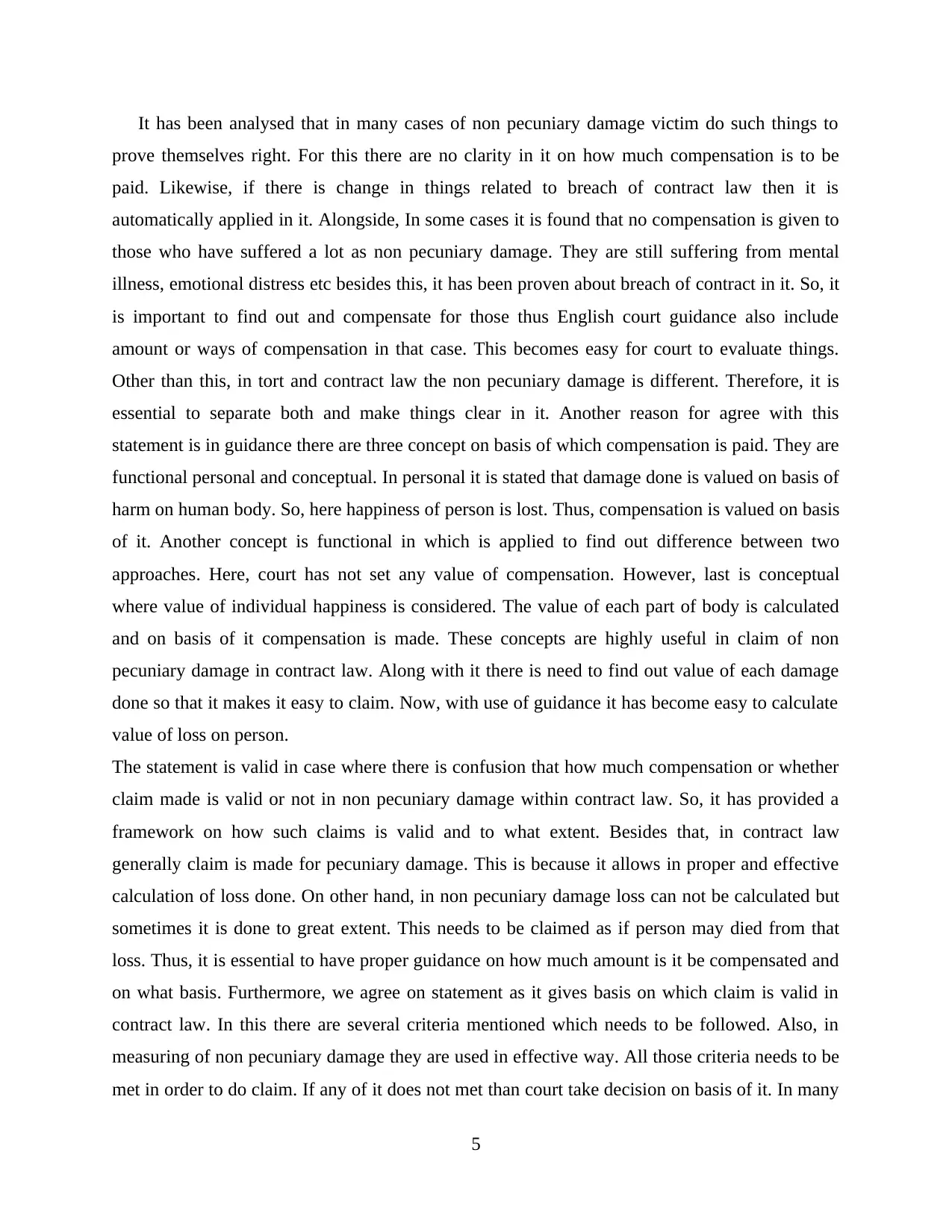
It has been analysed that in many cases of non pecuniary damage victim do such things to
prove themselves right. For this there are no clarity in it on how much compensation is to be
paid. Likewise, if there is change in things related to breach of contract law then it is
automatically applied in it. Alongside, In some cases it is found that no compensation is given to
those who have suffered a lot as non pecuniary damage. They are still suffering from mental
illness, emotional distress etc besides this, it has been proven about breach of contract in it. So, it
is important to find out and compensate for those thus English court guidance also include
amount or ways of compensation in that case. This becomes easy for court to evaluate things.
Other than this, in tort and contract law the non pecuniary damage is different. Therefore, it is
essential to separate both and make things clear in it. Another reason for agree with this
statement is in guidance there are three concept on basis of which compensation is paid. They are
functional personal and conceptual. In personal it is stated that damage done is valued on basis of
harm on human body. So, here happiness of person is lost. Thus, compensation is valued on basis
of it. Another concept is functional in which is applied to find out difference between two
approaches. Here, court has not set any value of compensation. However, last is conceptual
where value of individual happiness is considered. The value of each part of body is calculated
and on basis of it compensation is made. These concepts are highly useful in claim of non
pecuniary damage in contract law. Along with it there is need to find out value of each damage
done so that it makes it easy to claim. Now, with use of guidance it has become easy to calculate
value of loss on person.
The statement is valid in case where there is confusion that how much compensation or whether
claim made is valid or not in non pecuniary damage within contract law. So, it has provided a
framework on how such claims is valid and to what extent. Besides that, in contract law
generally claim is made for pecuniary damage. This is because it allows in proper and effective
calculation of loss done. On other hand, in non pecuniary damage loss can not be calculated but
sometimes it is done to great extent. This needs to be claimed as if person may died from that
loss. Thus, it is essential to have proper guidance on how much amount is it be compensated and
on what basis. Furthermore, we agree on statement as it gives basis on which claim is valid in
contract law. In this there are several criteria mentioned which needs to be followed. Also, in
measuring of non pecuniary damage they are used in effective way. All those criteria needs to be
met in order to do claim. If any of it does not met than court take decision on basis of it. In many
5
prove themselves right. For this there are no clarity in it on how much compensation is to be
paid. Likewise, if there is change in things related to breach of contract law then it is
automatically applied in it. Alongside, In some cases it is found that no compensation is given to
those who have suffered a lot as non pecuniary damage. They are still suffering from mental
illness, emotional distress etc besides this, it has been proven about breach of contract in it. So, it
is important to find out and compensate for those thus English court guidance also include
amount or ways of compensation in that case. This becomes easy for court to evaluate things.
Other than this, in tort and contract law the non pecuniary damage is different. Therefore, it is
essential to separate both and make things clear in it. Another reason for agree with this
statement is in guidance there are three concept on basis of which compensation is paid. They are
functional personal and conceptual. In personal it is stated that damage done is valued on basis of
harm on human body. So, here happiness of person is lost. Thus, compensation is valued on basis
of it. Another concept is functional in which is applied to find out difference between two
approaches. Here, court has not set any value of compensation. However, last is conceptual
where value of individual happiness is considered. The value of each part of body is calculated
and on basis of it compensation is made. These concepts are highly useful in claim of non
pecuniary damage in contract law. Along with it there is need to find out value of each damage
done so that it makes it easy to claim. Now, with use of guidance it has become easy to calculate
value of loss on person.
The statement is valid in case where there is confusion that how much compensation or whether
claim made is valid or not in non pecuniary damage within contract law. So, it has provided a
framework on how such claims is valid and to what extent. Besides that, in contract law
generally claim is made for pecuniary damage. This is because it allows in proper and effective
calculation of loss done. On other hand, in non pecuniary damage loss can not be calculated but
sometimes it is done to great extent. This needs to be claimed as if person may died from that
loss. Thus, it is essential to have proper guidance on how much amount is it be compensated and
on what basis. Furthermore, we agree on statement as it gives basis on which claim is valid in
contract law. In this there are several criteria mentioned which needs to be followed. Also, in
measuring of non pecuniary damage they are used in effective way. All those criteria needs to be
met in order to do claim. If any of it does not met than court take decision on basis of it. In many
5
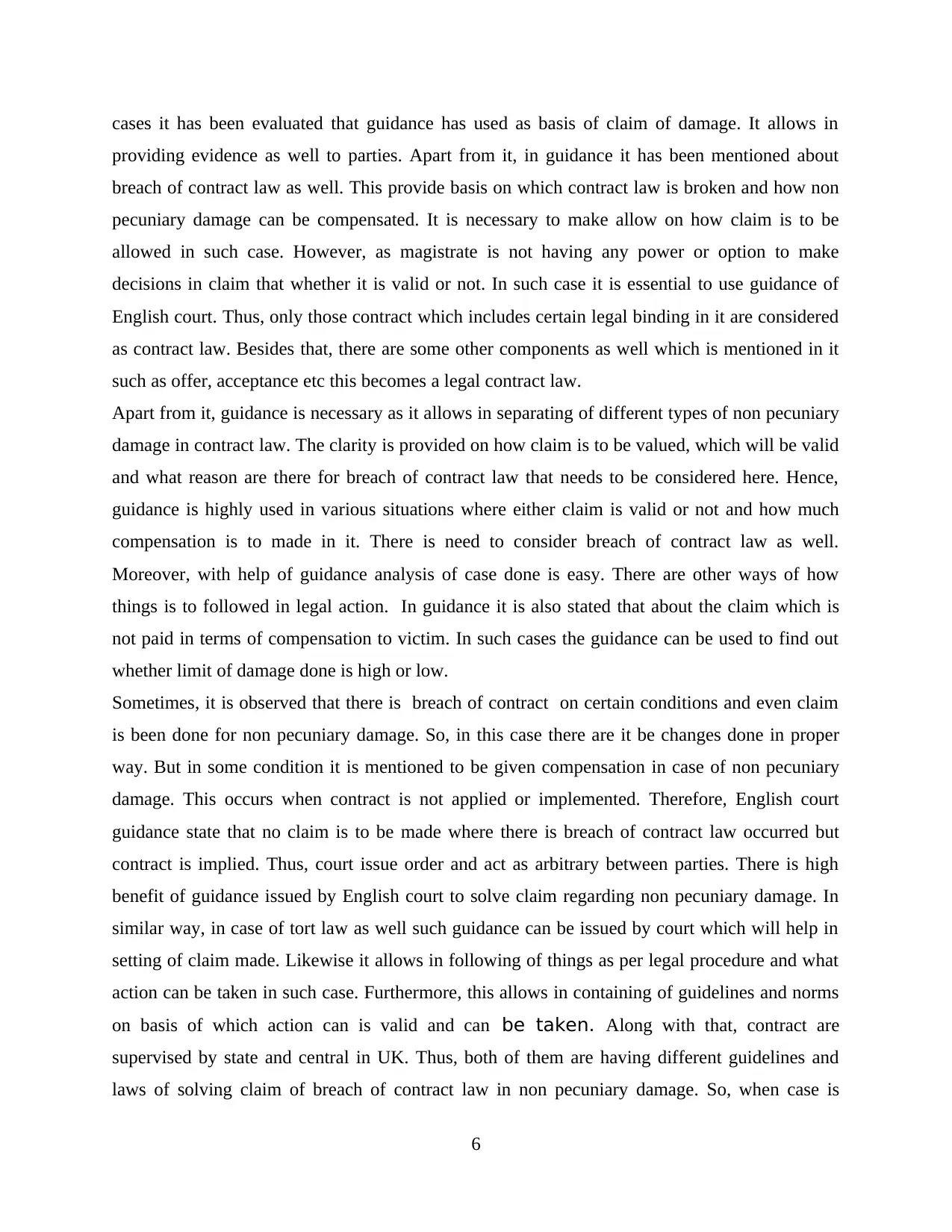
cases it has been evaluated that guidance has used as basis of claim of damage. It allows in
providing evidence as well to parties. Apart from it, in guidance it has been mentioned about
breach of contract law as well. This provide basis on which contract law is broken and how non
pecuniary damage can be compensated. It is necessary to make allow on how claim is to be
allowed in such case. However, as magistrate is not having any power or option to make
decisions in claim that whether it is valid or not. In such case it is essential to use guidance of
English court. Thus, only those contract which includes certain legal binding in it are considered
as contract law. Besides that, there are some other components as well which is mentioned in it
such as offer, acceptance etc this becomes a legal contract law.
Apart from it, guidance is necessary as it allows in separating of different types of non pecuniary
damage in contract law. The clarity is provided on how claim is to be valued, which will be valid
and what reason are there for breach of contract law that needs to be considered here. Hence,
guidance is highly used in various situations where either claim is valid or not and how much
compensation is to made in it. There is need to consider breach of contract law as well.
Moreover, with help of guidance analysis of case done is easy. There are other ways of how
things is to followed in legal action. In guidance it is also stated that about the claim which is
not paid in terms of compensation to victim. In such cases the guidance can be used to find out
whether limit of damage done is high or low.
Sometimes, it is observed that there is breach of contract on certain conditions and even claim
is been done for non pecuniary damage. So, in this case there are it be changes done in proper
way. But in some condition it is mentioned to be given compensation in case of non pecuniary
damage. This occurs when contract is not applied or implemented. Therefore, English court
guidance state that no claim is to be made where there is breach of contract law occurred but
contract is implied. Thus, court issue order and act as arbitrary between parties. There is high
benefit of guidance issued by English court to solve claim regarding non pecuniary damage. In
similar way, in case of tort law as well such guidance can be issued by court which will help in
setting of claim made. Likewise it allows in following of things as per legal procedure and what
action can be taken in such case. Furthermore, this allows in containing of guidelines and norms
on basis of which action can is valid and can be taken. Along with that, contract are
supervised by state and central in UK. Thus, both of them are having different guidelines and
laws of solving claim of breach of contract law in non pecuniary damage. So, when case is
6
providing evidence as well to parties. Apart from it, in guidance it has been mentioned about
breach of contract law as well. This provide basis on which contract law is broken and how non
pecuniary damage can be compensated. It is necessary to make allow on how claim is to be
allowed in such case. However, as magistrate is not having any power or option to make
decisions in claim that whether it is valid or not. In such case it is essential to use guidance of
English court. Thus, only those contract which includes certain legal binding in it are considered
as contract law. Besides that, there are some other components as well which is mentioned in it
such as offer, acceptance etc this becomes a legal contract law.
Apart from it, guidance is necessary as it allows in separating of different types of non pecuniary
damage in contract law. The clarity is provided on how claim is to be valued, which will be valid
and what reason are there for breach of contract law that needs to be considered here. Hence,
guidance is highly used in various situations where either claim is valid or not and how much
compensation is to made in it. There is need to consider breach of contract law as well.
Moreover, with help of guidance analysis of case done is easy. There are other ways of how
things is to followed in legal action. In guidance it is also stated that about the claim which is
not paid in terms of compensation to victim. In such cases the guidance can be used to find out
whether limit of damage done is high or low.
Sometimes, it is observed that there is breach of contract on certain conditions and even claim
is been done for non pecuniary damage. So, in this case there are it be changes done in proper
way. But in some condition it is mentioned to be given compensation in case of non pecuniary
damage. This occurs when contract is not applied or implemented. Therefore, English court
guidance state that no claim is to be made where there is breach of contract law occurred but
contract is implied. Thus, court issue order and act as arbitrary between parties. There is high
benefit of guidance issued by English court to solve claim regarding non pecuniary damage. In
similar way, in case of tort law as well such guidance can be issued by court which will help in
setting of claim made. Likewise it allows in following of things as per legal procedure and what
action can be taken in such case. Furthermore, this allows in containing of guidelines and norms
on basis of which action can is valid and can be taken. Along with that, contract are
supervised by state and central in UK. Thus, both of them are having different guidelines and
laws of solving claim of breach of contract law in non pecuniary damage. So, when case is
6
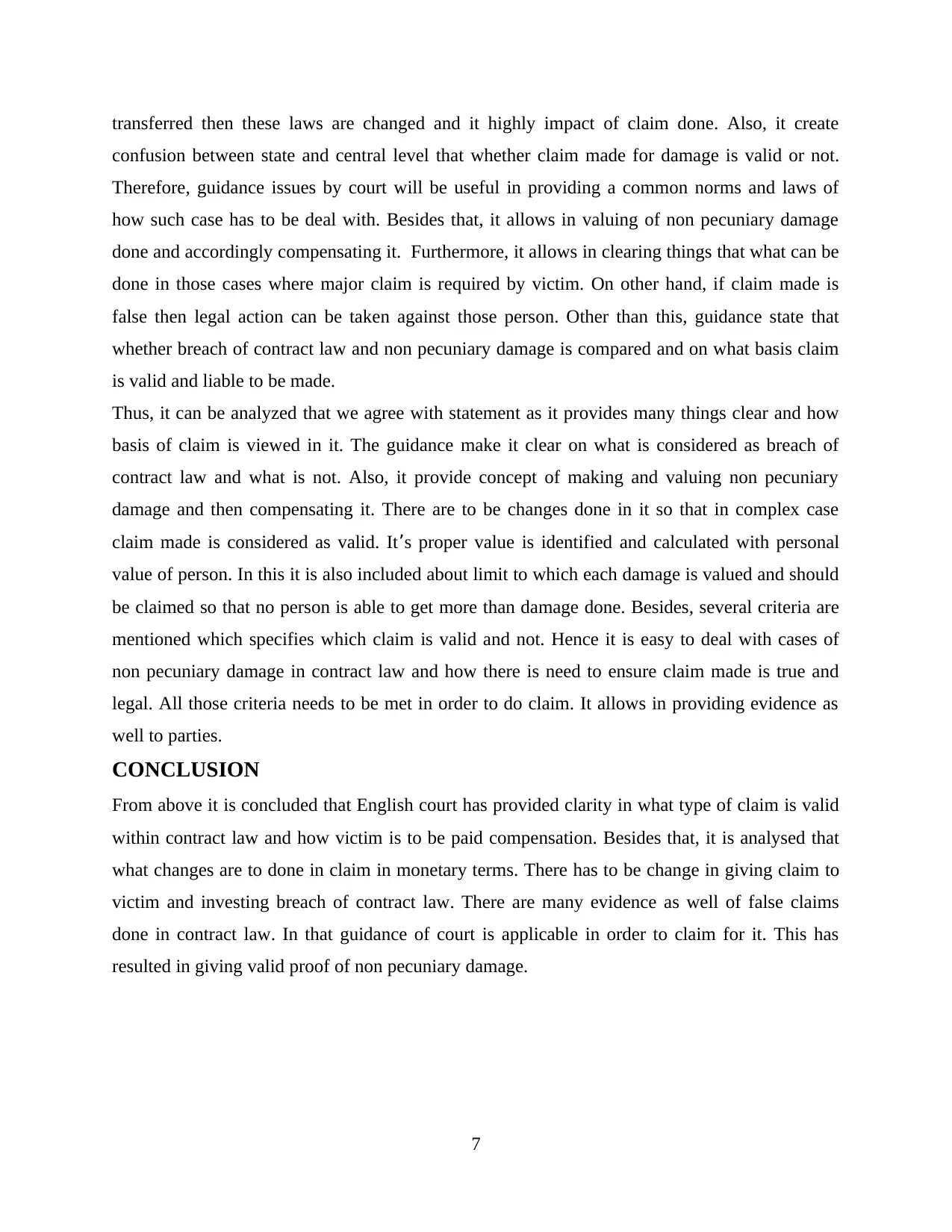
transferred then these laws are changed and it highly impact of claim done. Also, it create
confusion between state and central level that whether claim made for damage is valid or not.
Therefore, guidance issues by court will be useful in providing a common norms and laws of
how such case has to be deal with. Besides that, it allows in valuing of non pecuniary damage
done and accordingly compensating it. Furthermore, it allows in clearing things that what can be
done in those cases where major claim is required by victim. On other hand, if claim made is
false then legal action can be taken against those person. Other than this, guidance state that
whether breach of contract law and non pecuniary damage is compared and on what basis claim
is valid and liable to be made.
Thus, it can be analyzed that we agree with statement as it provides many things clear and how
basis of claim is viewed in it. The guidance make it clear on what is considered as breach of
contract law and what is not. Also, it provide concept of making and valuing non pecuniary
damage and then compensating it. There are to be changes done in it so that in complex case
claim made is considered as valid. It’s proper value is identified and calculated with personal
value of person. In this it is also included about limit to which each damage is valued and should
be claimed so that no person is able to get more than damage done. Besides, several criteria are
mentioned which specifies which claim is valid and not. Hence it is easy to deal with cases of
non pecuniary damage in contract law and how there is need to ensure claim made is true and
legal. All those criteria needs to be met in order to do claim. It allows in providing evidence as
well to parties.
CONCLUSION
From above it is concluded that English court has provided clarity in what type of claim is valid
within contract law and how victim is to be paid compensation. Besides that, it is analysed that
what changes are to done in claim in monetary terms. There has to be change in giving claim to
victim and investing breach of contract law. There are many evidence as well of false claims
done in contract law. In that guidance of court is applicable in order to claim for it. This has
resulted in giving valid proof of non pecuniary damage.
7
confusion between state and central level that whether claim made for damage is valid or not.
Therefore, guidance issues by court will be useful in providing a common norms and laws of
how such case has to be deal with. Besides that, it allows in valuing of non pecuniary damage
done and accordingly compensating it. Furthermore, it allows in clearing things that what can be
done in those cases where major claim is required by victim. On other hand, if claim made is
false then legal action can be taken against those person. Other than this, guidance state that
whether breach of contract law and non pecuniary damage is compared and on what basis claim
is valid and liable to be made.
Thus, it can be analyzed that we agree with statement as it provides many things clear and how
basis of claim is viewed in it. The guidance make it clear on what is considered as breach of
contract law and what is not. Also, it provide concept of making and valuing non pecuniary
damage and then compensating it. There are to be changes done in it so that in complex case
claim made is considered as valid. It’s proper value is identified and calculated with personal
value of person. In this it is also included about limit to which each damage is valued and should
be claimed so that no person is able to get more than damage done. Besides, several criteria are
mentioned which specifies which claim is valid and not. Hence it is easy to deal with cases of
non pecuniary damage in contract law and how there is need to ensure claim made is true and
legal. All those criteria needs to be met in order to do claim. It allows in providing evidence as
well to parties.
CONCLUSION
From above it is concluded that English court has provided clarity in what type of claim is valid
within contract law and how victim is to be paid compensation. Besides that, it is analysed that
what changes are to done in claim in monetary terms. There has to be change in giving claim to
victim and investing breach of contract law. There are many evidence as well of false claims
done in contract law. In that guidance of court is applicable in order to claim for it. This has
resulted in giving valid proof of non pecuniary damage.
7
Paraphrase This Document
Need a fresh take? Get an instant paraphrase of this document with our AI Paraphraser
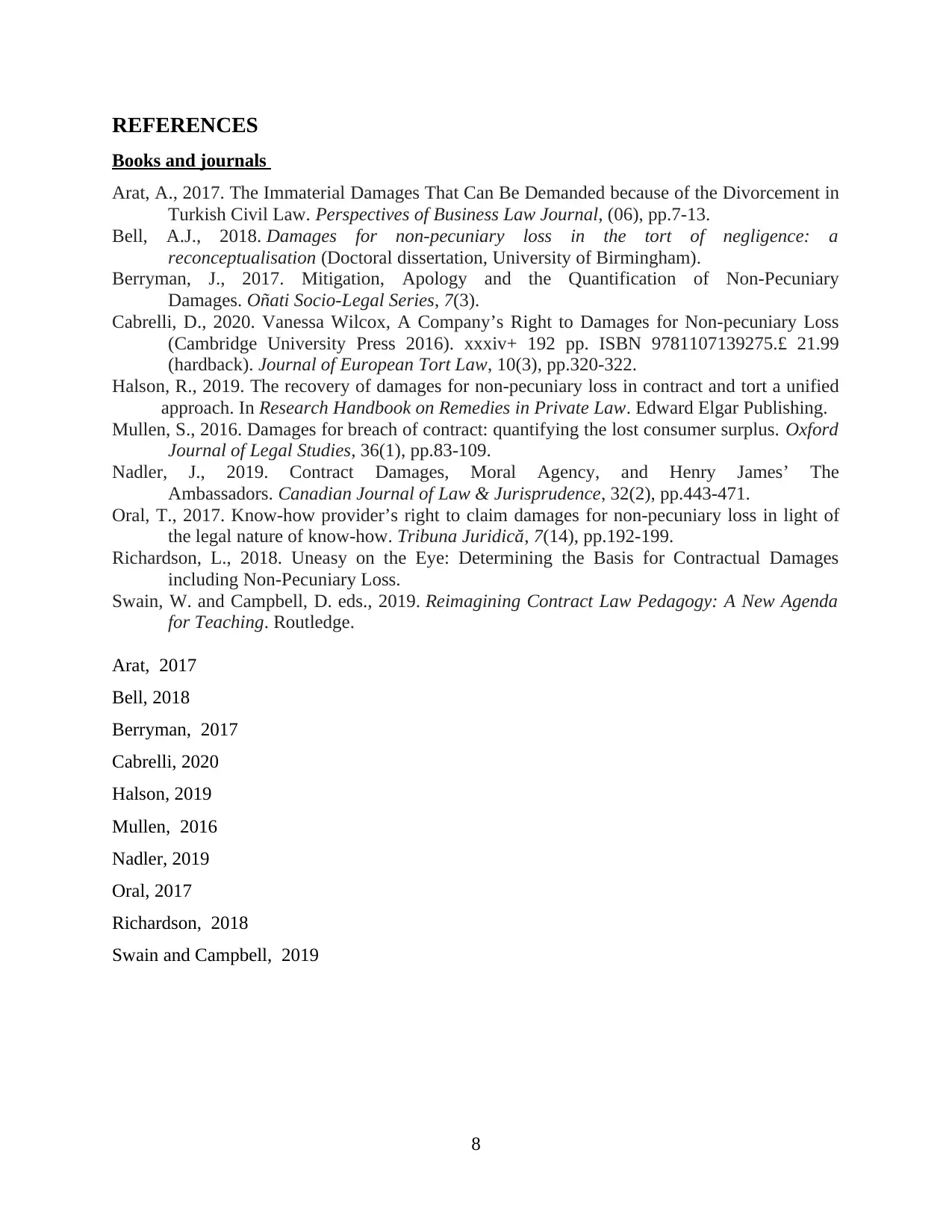
REFERENCES
Books and journals
Arat, A., 2017. The Immaterial Damages That Can Be Demanded because of the Divorcement in
Turkish Civil Law. Perspectives of Business Law Journal, (06), pp.7-13.
Bell, A.J., 2018. Damages for non-pecuniary loss in the tort of negligence: a
reconceptualisation (Doctoral dissertation, University of Birmingham).
Berryman, J., 2017. Mitigation, Apology and the Quantification of Non-Pecuniary
Damages. Oñati Socio-Legal Series, 7(3).
Cabrelli, D., 2020. Vanessa Wilcox, A Company’s Right to Damages for Non-pecuniary Loss
(Cambridge University Press 2016). xxxiv+ 192 pp. ISBN 9781107139275.£ 21.99
(hardback). Journal of European Tort Law, 10(3), pp.320-322.
Halson, R., 2019. The recovery of damages for non-pecuniary loss in contract and tort a unified
approach. In Research Handbook on Remedies in Private Law. Edward Elgar Publishing.
Mullen, S., 2016. Damages for breach of contract: quantifying the lost consumer surplus. Oxford
Journal of Legal Studies, 36(1), pp.83-109.
Nadler, J., 2019. Contract Damages, Moral Agency, and Henry James’ The
Ambassadors. Canadian Journal of Law & Jurisprudence, 32(2), pp.443-471.
Oral, T., 2017. Know-how provider’s right to claim damages for non-pecuniary loss in light of
the legal nature of know-how. Tribuna Juridică, 7(14), pp.192-199.
Richardson, L., 2018. Uneasy on the Eye: Determining the Basis for Contractual Damages
including Non-Pecuniary Loss.
Swain, W. and Campbell, D. eds., 2019. Reimagining Contract Law Pedagogy: A New Agenda
for Teaching. Routledge.
Arat, 2017
Bell, 2018
Berryman, 2017
Cabrelli, 2020
Halson, 2019
Mullen, 2016
Nadler, 2019
Oral, 2017
Richardson, 2018
Swain and Campbell, 2019
8
Books and journals
Arat, A., 2017. The Immaterial Damages That Can Be Demanded because of the Divorcement in
Turkish Civil Law. Perspectives of Business Law Journal, (06), pp.7-13.
Bell, A.J., 2018. Damages for non-pecuniary loss in the tort of negligence: a
reconceptualisation (Doctoral dissertation, University of Birmingham).
Berryman, J., 2017. Mitigation, Apology and the Quantification of Non-Pecuniary
Damages. Oñati Socio-Legal Series, 7(3).
Cabrelli, D., 2020. Vanessa Wilcox, A Company’s Right to Damages for Non-pecuniary Loss
(Cambridge University Press 2016). xxxiv+ 192 pp. ISBN 9781107139275.£ 21.99
(hardback). Journal of European Tort Law, 10(3), pp.320-322.
Halson, R., 2019. The recovery of damages for non-pecuniary loss in contract and tort a unified
approach. In Research Handbook on Remedies in Private Law. Edward Elgar Publishing.
Mullen, S., 2016. Damages for breach of contract: quantifying the lost consumer surplus. Oxford
Journal of Legal Studies, 36(1), pp.83-109.
Nadler, J., 2019. Contract Damages, Moral Agency, and Henry James’ The
Ambassadors. Canadian Journal of Law & Jurisprudence, 32(2), pp.443-471.
Oral, T., 2017. Know-how provider’s right to claim damages for non-pecuniary loss in light of
the legal nature of know-how. Tribuna Juridică, 7(14), pp.192-199.
Richardson, L., 2018. Uneasy on the Eye: Determining the Basis for Contractual Damages
including Non-Pecuniary Loss.
Swain, W. and Campbell, D. eds., 2019. Reimagining Contract Law Pedagogy: A New Agenda
for Teaching. Routledge.
Arat, 2017
Bell, 2018
Berryman, 2017
Cabrelli, 2020
Halson, 2019
Mullen, 2016
Nadler, 2019
Oral, 2017
Richardson, 2018
Swain and Campbell, 2019
8
1 out of 8
Related Documents
Your All-in-One AI-Powered Toolkit for Academic Success.
+13062052269
info@desklib.com
Available 24*7 on WhatsApp / Email
![[object Object]](/_next/static/media/star-bottom.7253800d.svg)
Unlock your academic potential
© 2024 | Zucol Services PVT LTD | All rights reserved.





